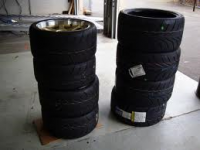The summer of 2013 was one of the hottest and driest summers Canada has experienced in recent history with new weather records set in almost every part of the country. While many sun worshippers flocked to their local parks and beaches to soak up the rays, those of us with a quest for speed soaked in the rays at our local race track. While slathered in the appropriate SPF protection we made those small adjustments which we hope, would deliver us to the victory podium.
- Remove race tires from the vehicle and deflate to half the normal air pressure.
The expansion and contraction of the air in an inflated tire is more extreme in the fall and winter with very cold temperatures at night and warmer temperatures during the day. As a fully inflated tire under the weight of vehicle doesn’t have the ability to absorb this expansion the race tire may develop cracks in the tire casing. By removing the tire from the car and deflating the pressure you’ll provide the space for the tire pressure to increase and decrease with the change in temperatures.
- Store them clean but not oiled up
Store your race tires as clean as possible. Wipe them off or better yet wash them with simple soap and water to get any oil, brake dust, or dirt off of them. DO NOT cover them in a chemical that supposedly makes them look good. These chemicals at the best of times are not great for your rubber compound, letting them sit all winter soaking in is an even worse idea.
- Protect the tires from exposure to direct sunlight and ozone.
Both UV light and ozone can deteriorate the special compound used in race tires. When not in use race tires should be stored in protective tire bags, and believe it or not, away from machinery such as electric motors or chemicals like fertilizers that can emit ozone. For lack of a better analogy treat your stored tires like a potato- store them in a cool dark place. But not too cool! Freezing temperatures can have ill effects on race tires as well.- If you are like some and must remove them from their rims then the tires should be stacked on their sides rather than upright. But don’t stack them more than 4 high.
- If they happen to have white lettering and are not in separate bags store them white to white to further avoid the chance of cracking or discoloration.
- Inspect tires prior to first use
Before hitting the track next spring take a minute to inspect your race tires. Tires that have cracks are susceptible to failing and may result in serious injury or death. Never use tires that have cracked!





